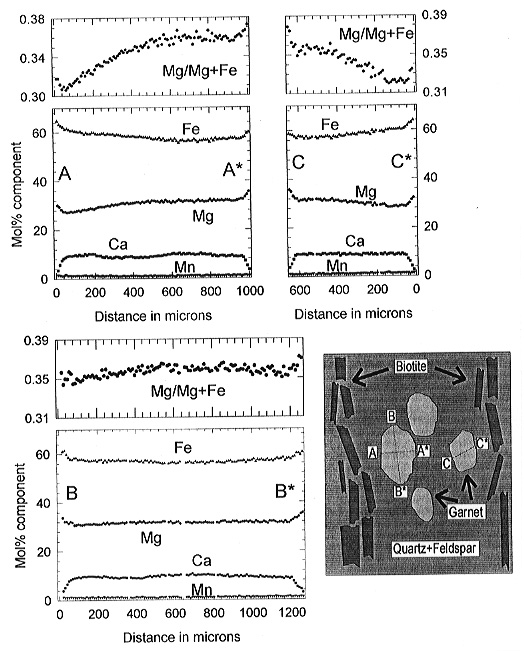

The temporal changes in thermal and baric conditions experienced by rocks as a result of processes driven by plate-tectonics (e.g. inter- and intra-crustal thrusting, metamorphism, and magmatism) define pressure-temperature-time (P-T-t) paths. Our ability to recover P-T-t paths in natural rocks is dependent on the correct interpretation of pressure-temperature information encoded in the form of preserved mineral assemblages, mineral compositions and reaction textures. Timescales for metamorphic evolution can be derived from measurements of radiogenic isotopes or from an evaluation of time-dependent processes such as diffusion. Compositional variation within certain major rock-forming minerals, such as garnet, is common in metamorphic rocks of all grades and the recognition and detailed investigation of such zoning is extremely important when trying to reconstruct P-T-t-paths for metamorphic terranes. In rocks that were not exposed to extreme temperatures, features such as growth zoning and overgrowths in garnet can be very useful in elucidating the metamorphic history. As metamorphic grade increases however, volume diffusion (or recrystallisation) tends to lead to homogenisation of compositional variations and, as a result, usually only the post-peak-temperature cooling history will be recorded. If suitable diffusion coefficients are available, such profiles can be interpreted to yield limits to possible cooling rates for the rocks and thus help to further characterise and constrain the P-T-t-path. Diffusion models are also used to deduce the maximum recoverable temperature (i.e., closure temperature) for grains of a given size that followed a particular T-t-path. One of the most important assumptions in closure temperature modelling is that material transport rates outside are significantly faster than within the phase itself. The validity of this important assumption is rarely tested.
In the example described here, Fe-Mg zoning patterns in garnet from
a sample of overprinted high pressure-high temperature granulite are independent
of grain size. Breakdown reactions in the sample have resulted in the growth
of linear domains of biotite and plagioclase at the expense of garnet and
K-feldspar. Compositional mapping of domains of the granulites reveal that
garnets close to the biotite-bearing areas show strongly asymmetrical Fe/Mg
patterns with Fe much higher in the parts of garnet facing biotite. The
presence of non-concentric zoning patterns in the affected garnets means
that line-profiles across the same grain can be very different. Profiles
parallel to the biotite trend are flat in the core, whereas those perpendicular
to the biotite-rich lenses are strongly sloped towards higher Fe in the
direction of the biotite (Fig. 3.4-4). As a consequence, values for XMg(XMg=Mg/(Mg
+ Fe)) at different positions at the rim of the same garnet differ considerably.
For example profile B-B*, parallel to the biotite texture, shows a near
constant core XMg value of 0.35 rising slightly at the rim whereas
profile A-A*, measured perpendicular to B-B*, exhibits XMg values
of 0.32 at the rim close to biotite and a value of 0.37 at the rim furthest
away from the biotite zone.
 |
|
|
Diffusion in garnet is slow and so it is usually assumed that the transport of material (here Fe and Mg) along grain boundaries, to and from the garnet rim, will be faster than the rate at which it is taken up. The result of this assumption is that the garnet rim, regardless of whether it was the side facing the biotite or the side further away, would have the same effective chemical communication with the biotite thus resulting in concentric zoning. The absence of the expected concentric zoning pattern must mean that the supply of material by grain boundary diffusion (through a feldspar-quartz matrix) was as slow as in the garnet itself. This is probably due to the absence, or scarcity, of a pervasive fluid phase during the high grade metamorphism. The result is that a simple relationship between grain size and retention of major element patterns (for geothermobarometry) and perhaps even isotopes (for geochronology) does not exist. Using diffusion modelling to recover time information from such a sample (geospeedometry) is extremely difficult as, contrary to the commonly applied models with simple assumptions, grain boundary diffusion rates, transport distances from garnet to biotite and domainal bulk chemical patterns must all be taken into consideration.

Tel: +49-(0) 921 55 3700 / 3766, Fax: +49-(0) 921 55 3769, E-mail: bayerisches.geoinstitut(at)uni-bayreuth.de
 Previous page
Previous page